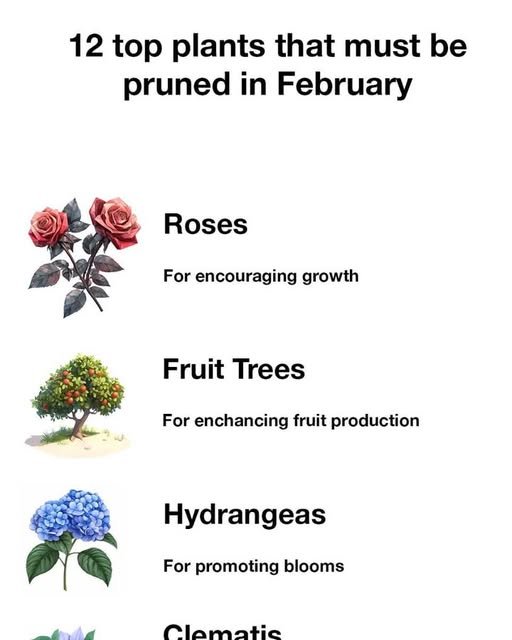February is a pivotal month for gardeners looking to prepare their plants for the upcoming growing season. As winter begins to wane, many plants are still dormant, making it an ideal time to prune. Pruning during this period helps to shape plants, remove dead or diseased wood, and encourage new growth. With the right techniques and timing, February pruning can set the stage for a vibrant and healthy garden come spring.
Understanding the Importance of Pruning
Pruning is an essential horticultural practice that involves the selective removal of certain parts of a plant, such as branches, buds, or roots. The primary reasons for pruning include improving plant health, controlling growth, enhancing flowering and fruiting, and maintaining a desired shape. Proper pruning can prevent disease, improve air circulation, and allow sunlight to penetrate the plant canopy, all of which contribute to a more robust plant.
Factors to Consider Before Pruning
Before you start pruning, it’s important to understand the specific needs of each plant species. Consider the plant’s growth habit, flowering time, and overall health. It’s also crucial to use the right tools, such as sharp pruners or loppers, to make clean cuts that heal quickly. Be mindful of the weather, as pruning during extremely cold or wet conditions can harm the plant. Lastly, always sanitize your tools to prevent the spread of disease.
Top Plants for February Pruning
Certain plants benefit significantly from February pruning. This section highlights twelve plants that should be pruned during this month to ensure healthy growth and abundant blooms in the coming seasons.
1. Roses: Encouraging New Growth
Roses are best pruned in February when they are still dormant. This timing helps to stimulate vigorous new growth and abundant flowering. Cut back to outward-facing buds to open up the center of the plant, which improves air circulation and reduces the risk of disease.
2. Fruit Trees: Enhancing Fruit Production
Pruning fruit trees in February helps to shape the tree, remove dead or diseased wood, and encourage the growth of new fruiting wood. Focus on removing any crossing branches and thinning the canopy to allow sunlight to reach all parts of the tree.
3. Hydrangeas: Promoting Bloom Health
For hydrangeas, February pruning depends on the type. For those that bloom on new wood, such as ‘Annabelle’ and ‘Limelight’, cut back the stems to about a foot from the ground. This encourages strong new growth and larger blooms.
4. Clematis: Ensuring Vigorous Flowering
Clematis varieties that bloom on new wood should be pruned in February. Cut back all stems to about 12 inches above the ground. This encourages new growth and ensures a spectacular display of flowers later in the season.
5. Grapevines: Improving Fruit Quality
Pruning grapevines in February is crucial for controlling their growth and improving fruit quality. Remove up to 90% of the previous year’s growth, leaving only a few buds per cane. This focuses the plant’s energy on producing high-quality grapes.
6. Wisteria: Controlling Aggressive Growth
Wisteria can become unruly if not pruned regularly. In February, cut back the long shoots from the previous year to just two or three buds. This keeps the plant manageable and encourages flowering.
7. Butterfly Bush: Maintaining Shape and Size
Prune butterfly bushes in February to maintain their shape and size. Cut back the previous year’s growth to about 12 inches from the ground. This encourages a bushy growth habit and more prolific flowering.
8. Ornamental Grasses: Preparing for Spring
Ornamental grasses should be cut back in February before new growth begins. Trim them to a few inches above the ground to remove dead foliage and make way for fresh, new growth in spring.
9. Lavender: Encouraging Bushy Growth
Prune lavender in February to promote a bushy growth habit and prevent the plant from becoming woody. Trim back about one-third of the plant, being careful not to cut into old wood.
10. Dogwood: Enhancing Structural Form
Pruning dogwood trees in February helps to enhance their structural form and remove any dead or diseased branches. Focus on maintaining an open canopy to improve air circulation and light penetration.
11. Fuchsia: Stimulating New Blooms
Fuchsias benefit from a February prune to stimulate new blooms. Cut back the previous year’s growth by about half, focusing on removing any weak or crossing branches.
12. Boxwood: Maintaining Desired Shape
Boxwoods are often pruned in February to maintain their desired shape and size. Use sharp shears to trim the plant evenly, being careful not to cut too deeply into the older wood.
Conclusion: Benefits of Timely Pruning
Pruning in February offers numerous benefits, including improved plant health, enhanced flowering and fruiting, and better control over plant size and shape. By understanding the specific needs of each plant and using the right techniques, gardeners can ensure a thriving garden that bursts with life and color in the spring and beyond.



